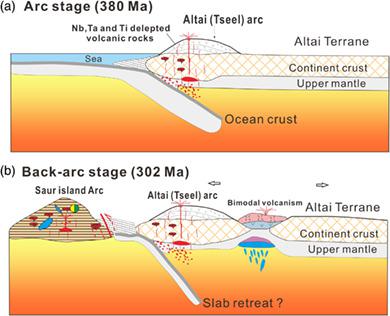当前位置:
X-MOL 学术
›
Geolog. J.
›
论文详情
Our official English website, www.x-mol.net, welcomes your feedback! (Note: you will need to create a separate account there.)
Late Palaeozoic magmatism in the eastern Tseel Terrane of SW Mongolia evidenced by chronological and geochemical data
Geological Journal ( IF 1.8 ) Pub Date : 2020-10-28 , DOI: 10.1002/gj.4026 Tao Hong 1, 2, 3 , Jun Gao 3, 4, 5 , Xing‐Wang Xu 3, 4, 5 , Chu Wu 3, 4, 6 , Hao Li 3, 4
Geological Journal ( IF 1.8 ) Pub Date : 2020-10-28 , DOI: 10.1002/gj.4026 Tao Hong 1, 2, 3 , Jun Gao 3, 4, 5 , Xing‐Wang Xu 3, 4, 5 , Chu Wu 3, 4, 6 , Hao Li 3, 4
Affiliation

|
The eastern Tseel Terrane of SW Mongolia, which is an important part of the Central Asian Orogenic Belt (CAOB), contains a segment of imbricated sheets of Late Palaeozoic granites as well as a bimodal volcanic suite. Late Devonian (380–382 Ma) granites that are enriched in Th, U, and K and depleted in Nb, Ta, P, Ba, Sr, and Ti indicate arc magmatism and are low-K tholeiitic to medium-K calc-alkaline series. Zircon εHf(t) values are of +8.30 to +14.1, with crustal model ages of 0.83–0.48 Ga. The bimodal volcanic suite is composed of N-MORB basalt and 302 ± 2 Ma rhyolite having A2-type granite affinities, εHf(t) values ranging from +9.9 to +11.9, and crustal model ages from 0.69 to 0.59 Ga. The rhyolite mighthave originated from partial melting of juvenile lower crust, rather than fractional crystallization of coeval basaltic magma. Late Carboniferous (299–303 Ma) granites are medium-K to high-K calc-alkaline series, cross-cutting carbonaceous siltstone, emplaced into the deformed volcanic rocks and are characterized by enrichment in K, Th, and U accompanied by depletion in Ba, Nb, Ta, Sr, P, and Ti in a primitive mantle-normalized diagram with εHf(t) values ranging from +6.05 to +10.6 and crustal model ages from 0.70 to 0.65 Ga. Thus, LA-ICP-MS zircon ages in combination with geochemical data document a phase of arc-related magmatism in the Tseel Terrane at 380–382 Ma. These rocks were subsequently deformed under low-grade metamorphic conditions and intruded by undeformed granites at c. 299–303 Ma. The coeval 302 Ma rhyolite in bimodal volcanic suite shows typical A2-type granitic geochemical affinities and probably documents a back-arc basin extensional environment, which was probably related to the roll-back of the Palaeo-Asian Oceanic Plate during the northward subduction under the Central Mongolia microcontinent.
中文翻译:

年代学和地球化学资料证实的蒙古西南部采尔地块东部晚古生代岩浆活动
蒙古西南部策尔地块东部是中亚造山带(CAOB)的重要组成部分,包含一段晚古生代花岗岩叠瓦片和双峰火山岩套。晚泥盆世 (380–382 Ma) 富含 Th、U 和 K 并缺乏 Nb、Ta、P、Ba、Sr 和 Ti 的花岗岩表明弧岩浆作用并且是低 K 拉斑岩至中 K 钙碱性系列。锆石εHf(t)值为+8.30~+14.1,地壳模型年龄0.83~0.48 Ga。双峰火山岩组由N-MORB玄武岩和302±2 Ma流纹岩组成,A 2型花岗岩亲和性,εHf(t) 值范围为 +9.9 至 +11.9,地壳模型年龄为 0.69 至 0.59 Ga。流纹岩可能起源于幼年下地壳的部分熔融,而不是同时期玄武质岩浆的分步结晶。晚石炭世(299-303 Ma)花岗岩为中钾至高钾钙碱性系列,横切碳质粉砂岩,侵位变形火山岩,以K、Th、U富集伴贫化为特征。 Ba、Nb、Ta、Sr、P 和 Ti 在原始地幔归一化图中,εHf(t) 值范围从 +6.05 到 +10.6,地壳模型年龄从 0.70 到 0.65 Ga。因此,LA-ICP-MS 锆石年龄结合地球化学数据记录了 380-382 Ma 在 Tseel Terrane 中与弧相关的岩浆作用阶段。C。299–303 马。双峰火山岩套中的同时代 302 Ma 流纹岩显示出典型的 A 2型花岗岩地球化学亲和性,可能记录了弧后盆地伸展环境,这可能与古亚洲大洋板块在下俯冲过程中向北俯冲过程中的回滚有关。蒙古中部微大陆。
更新日期:2020-10-28
中文翻译:

年代学和地球化学资料证实的蒙古西南部采尔地块东部晚古生代岩浆活动
蒙古西南部策尔地块东部是中亚造山带(CAOB)的重要组成部分,包含一段晚古生代花岗岩叠瓦片和双峰火山岩套。晚泥盆世 (380–382 Ma) 富含 Th、U 和 K 并缺乏 Nb、Ta、P、Ba、Sr 和 Ti 的花岗岩表明弧岩浆作用并且是低 K 拉斑岩至中 K 钙碱性系列。锆石εHf(t)值为+8.30~+14.1,地壳模型年龄0.83~0.48 Ga。双峰火山岩组由N-MORB玄武岩和302±2 Ma流纹岩组成,A 2型花岗岩亲和性,εHf(t) 值范围为 +9.9 至 +11.9,地壳模型年龄为 0.69 至 0.59 Ga。流纹岩可能起源于幼年下地壳的部分熔融,而不是同时期玄武质岩浆的分步结晶。晚石炭世(299-303 Ma)花岗岩为中钾至高钾钙碱性系列,横切碳质粉砂岩,侵位变形火山岩,以K、Th、U富集伴贫化为特征。 Ba、Nb、Ta、Sr、P 和 Ti 在原始地幔归一化图中,εHf(t) 值范围从 +6.05 到 +10.6,地壳模型年龄从 0.70 到 0.65 Ga。因此,LA-ICP-MS 锆石年龄结合地球化学数据记录了 380-382 Ma 在 Tseel Terrane 中与弧相关的岩浆作用阶段。C。299–303 马。双峰火山岩套中的同时代 302 Ma 流纹岩显示出典型的 A 2型花岗岩地球化学亲和性,可能记录了弧后盆地伸展环境,这可能与古亚洲大洋板块在下俯冲过程中向北俯冲过程中的回滚有关。蒙古中部微大陆。


























 京公网安备 11010802027423号
京公网安备 11010802027423号